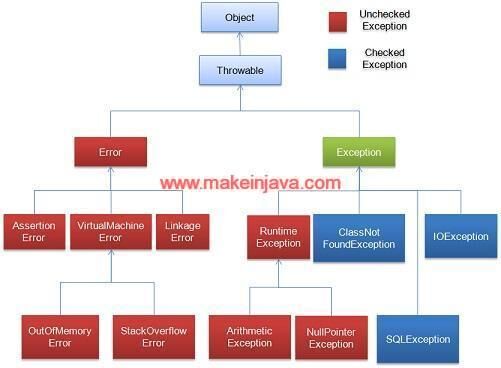- We will discuss the difference between error & exception in java.
- We will demonstrate exception class hierarchy in java.
- We have shown checked & unchecked exception class hierarchy in Fig 1..
- We will discuss the examples of error & exceptions in java.
1. Exception class hierarchy in java
- We have shown some of the concrete classes of exceptions in Fig 1.
- java.lang.Throwable is base class for all types of exceptions (and errors).

- Broadly the exceptions are categorized into two parts (Refer Fig 1 for checked and unchecked exceptions)
- Unchecked exceptions
- Sub classes of Error and RuntimeException are unchecked exceptions.
- Checked exceptions
- Except Unchecked exceptions, rest of all exceptions are checked exceptions.
- Unchecked exceptions
- The Errors are unchecked exceptions.
- All the errors are under package java.lang.Error
- e.g. AssertionError, VirtualMachineErrors, LinkageErrors
2. Difference between errors & exceptions in java (examples)
| No. | Error | Exception |
|---|---|---|
| 1 | Errors occur in an application due to lack of system resources. For example: StackOverflowError occurs, when stack size is exhausted or NoClassDefFoundError occurs when particular class is not available or OutOfMemoryError occurs when JVM does not have enough memory | Exception occurs in an application mostly due to programming mistakes. For example: ClassCastException occurs, when we try to cast incompatible classes or ArrayIndexOutOfBoundsException occurs, when we try to access the array index beyond its bounds. |
| 2 | We can catch the error conditions, but we can not recovers from error conditions. For example: If OutOfMemoryError occurred, we just cannot recover from it. We can catch the error just for logging purpose etc. | We can catch the exceptions using catch blocks and recover from them. For example: If ArrayIndexOutOfBoundsException occurs, in catch block we can introspect the error condition, correct the exception condition and resume the normal flow of application. |
